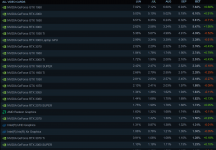AMD?
The top.. I dunno - 20-something or so models, I pasted a screen grab below.
You don't get to a specific AMD model until the RX580 at #25, and a current gen AMD until the RX6600 at something around #50. I didn't go and add it up, but all the AMD cards together look to be somewhere around .. 7-9% marketshare? Which compares to the nVidia 1060 - just that one model, all by itself.
Now, I defend the underdog a good bit (I don't consider myself a Republican or Democrat, I like to root for the underdog and the outsider) - but here's some real criticism of AMD. I thought AMD hit that same price/performance gap that the current 4000 vs 7000 lineup is looking to hit.
But... they are almost no where to be found in this list. The 6800XT is sitting at 0.16% -- almost at the dead last position. The 6900XT is not that many spots ahead of it - at 0.18% (The XTX isn't even listed).
Now, I don't think that's entirely because they are being shunned and poor AMD. My list is a lot of hyperbole, but a good bit of it is legitimate, and one of my biggest gripes is that AMD went in gunshy and just didn't allocate production. My circumstantial evidence: these installation numbers.
There are only 2 ways I can think of to explain these dismal numbers that are plausible: The first is that AMD is doing just that poor in sales. And that is possible, for all the reasons I listed (real and fake) and dozens of other ones I haven't even put to text - but we just went through a period where Every. Single. GPU. Made. Sold. Now, most of that was to miners, but tend to make their way to gamers as well eventually, and nVidia sold it's fair share of cards (and then some) to miners as well, so it wasn't just "Oh the miners got them all".
The other would be that AMD only has a finite amount of fab allocation, and is choosing to prioritize their CPU production at the expense of their GPU production. Now, AMD seems to be selling every bit they can produce, and CPU dies are ~much~ smaller than GPU dies, which makes them (I suspect) more profitable. So I can't really blame AMD for making the business decision, but as a gamer, it really is allowing nVidia such a dominant position that I hate to see it.
I said only 2 ways to explain this: there are 3 more I can possibly think of, but I also discount them. But for the purposes of being complete:
You could also say it's because Steam is just a small subset of gamers and these numbers in no way reflect real life. I'd counter saying - yes, it's a subset, but it's more than large enough to be statistically significant. They may not be absolutely accurate in terms of actual marketshare, but I believe they are going to be relatively indicative of how the market looks overall. And it could be those generic "AMD" entries (and Intel and others) are the countless cards that I'm looking for, just misidentified in either the reporting or by the driver -- but just looking at the magnitude of it all, I don't think that comes close to the magnitude of canceling out my criticism. And you can say these Steam numbers get way skewed by Asian gaming cafes. To that, I say - they are gaming too - why shouldn't they be counted? Maybe they should be counted multiple times, because multiple gamers are leveraging the same hardware (depending on if you want the Hardware survey to be indicative of physical hardware sales/installations, or what hardware gamers are using to play - which are similar but not identical metrics)
View attachment 2051

